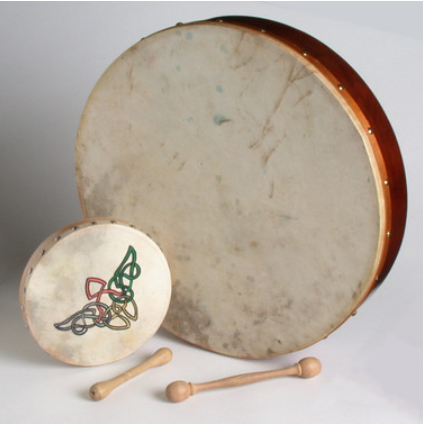The Bodhran is one of the iconic instruments of Irish music. Having first come into vogue during the great folk revival in the 1960s, its use has only grown since.
Today’s playing style for this Irish drum has evolved into a complex yet contemporary experience, fully exploring its musical scope. Additionally, its practitioners, pedagogues, and makers form an active community of practitioners and makers who continuously innovate new ideas and techniques.
Origins
Origins of Bodhran Drum Music remain uncertain; many speculate it came to Ireland with Celtic migrations from Europe while others think its source could have been Asia or Africa.
A traditional Irish drum, known as a bodhran is composed of a wooden frame covered with goatskin stretched over it. To play the instrument you use a beater known as a “cipin or tipper.”
In its early days, the bodhran featured jingles similar to modern tambourines; however, this practice has mostly been abandoned since players now dampen sound with one hand on the underside of drum skin, creating a much more refined sound.
Techniques
The bodhran drum is an instrument which requires skill and technique in order to play proficiently, offering you an ideal way of learning traditional Irish music if you commit yourself to practicing on it regularly. If this sounds appealing to you then go forth with it – your efforts could pay off!
Bodhran drum music can be enjoyed both sitting or standing up. Most players prefer holding their drum erect on their thigh with one hand.
There are various techniques used in playing bodhran drum, including striking the edge of the skin and ornamentation through using the tipper, that can help achieve various pitches and sound characteristics. These can be highly effective.
Additionally, the bodhran can be tuned internally by attaching a tone ring directly against its skin. This method negates atmospheric influences on drumhead tension for more accurate tuning results.
Styles
Music has long been used as a medium for expressing feelings and ideas, as well as sharing our lives’ narratives. Indeed, it acts as a mirror that shows us our deepest emotions and feelings.
Irish music has long relied upon the bodhran drum as an integral instrument. Its revival began during O Riada’s revival efforts during the 1960s.
After O Riada, other players such as Peadar Mercier, Johnny “Ringo” McDonagh and John Joe Kelly also helped elevate the bodhran to new levels. These men revolutionised how this simple drum could be played while also reinstating its place within traditional Irish music.
Rhythms
Bodhran drums are Irish folk instruments consisting of a frame drum with goatskin or another material for its head and frame, used to accompany music performances.
The head of a drum is typically connected to its frame with jingles, and can be played using either a beater/tippper stick, or by playing with one’s hands directly. A bodhran may be used to produce various rhythms.
Bodhran drum music is often played alongside other instruments or as an accentuating factor when creating specific tunes, making this form of music especially popular in folk and traditional Irish music.
The bodhran can be played to accent many different rhythms and uses various techniques to give its beat an unique sound, including playing rimshots, shifting stick position and altering timbre of beat.
Instruments
A bodhran is a flat drum made up of a hoop frame with stretched goatskin stretched over it. Common materials for construction of this drum include birch or ash wood with crossed wooden bars for stability behind its goatskin covering.
Modern bodhrans come equipped with inbuilt tuning systems that allow them to be tuned like guitars and pianos to alter the tone. As such, these sophisticated musical instruments have become staples among Irish traditional music musicians.
Irish percussionists such as Peadar Mercier and his son Mel have taken the bodhran to new levels, while Sean O Riada and Johnny McDonagh have reintroduced drumming to Irish Traditional Music bands.




